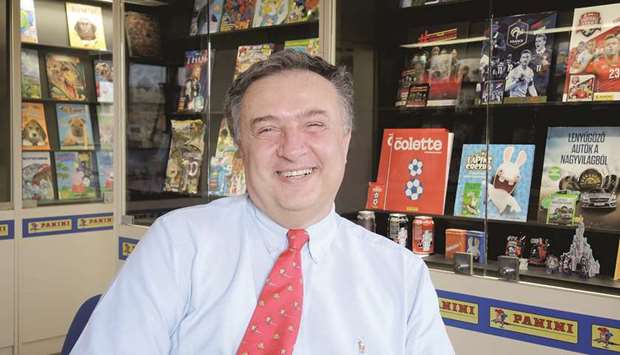A visit to Panini Group headquarters feels like a return to childhood - only the footballers’ faces on the millions of stickers moving down the production line are different.
Gone are the likes of Pele, Maradona, Cruyff, Beckenbauer and Best, replaced by players on the 32 national teams to take part in the upcoming 2018 World Cup in Russia.
The world leader in the collectables and trading cards market, Panini has been publishing World Cup sticker albums since 1970. Ever since, buying and swapping the self-adhesive stickers to fill up one’s album has been a pastime of countless kids - and some adults, too.
This year, a full collection comprises 682 stickers, and single packs contain five randomly sorted stickers, so duplicates can make it difficult to complete the 80-page album.
There’s also the possibility that Panini fails to print the photo of a player selected for a World Cup team, or prints one of a player who doesn’t make the final cut.
“We have the most difficult task in the world,” says Fabrizio Melegari, Panini’s editorial director. “We’ve got to think with the heads of 32 different coaches.”
The World Cup brainstorming starts immediately after the previous tournament ends. Month after month for four years, the firm follows the national football teams of some 50 countries, evaluates player statistics and talks with local journalists and football experts.
“It’s a very long process filled with difficulties and frustration,” Melegari says.
The error rate is about 12 per cent, he notes, adding that while the Iranian roster was among those that were hard to predict this year, he’s certain about defending champions Germany.
“These are the players who will be selected” by head coach Joachim Loew, Melegari says of Panini’s picks, a group most experts agree on.
The 18 players include stalwarts from the 2014 side, such as Mario Goetze and Mesut Ozil, along with talented newcomers such as Joshua Kimmich and Julian Brandt. “They surely were photographed on the day they learned they were possible World Cup candidates,” says Melegari, referring to the smiling faces. He notes that the Brazilians look rather sombre by comparison, quipping that they’re still smarting from their showing on home turf four years ago. But Brazil’s pages in the new sticker album are, as always, the most colourful ones, he adds.
The stickers are sorted and packaged in Modena and at the Panini plant in Sao Paolo, Brazil. Production at both locations is ramped up ahead of a World Cup, says Giuseppe Tagliavini, Panini’s production and technical director. Europe and South America are the most important markets for the stickers, available in 130 countries.
Tagliavini won’t disclose the size of the print run, past sales volumes or the best-selling sticker album. He does say, however, that the 2006 and 2014 World Cups in Germany and Brazil, respectively, were very successful for Panini.
The company was founded in 1961 by Giuseppe Panini, the eldest of four brothers. Benito joined him that year, and Umberto and Franco in 1963. The brothers had opened a newsstand in the historic district of Modena in 1945, and then started a newspaper distribution agency in 1954. Besides its collectables and trading cards business, Panini is one of the leading publishers of children’s magazines and books, comics, manga and graphic novels in both Europe and Latin America.
In the administration building next door, Melegari leafs through World Cup sticker albums of bygone days: Mexico 1986, Argentina 1978.
The portraits of the players now seem more thought out: The players are usually looking in the same direction or directly into the camera, and the backgrounds are the same. Now a days, teams attach more importance to hairstyling than to “epic poses” like those of combatants, Melegari says.
Panini has launched a digital ‘sticker’ album for the 2018 World Cup, enabling football fans to download images of players online.
The new virtual album isn’t likely to supplant the old version anytime soon though.
“As regards the concept, it’s the same product as in the 1960s,” Melegari says. “The suspense in whether I’ll find [German footballer] Thomas Mueller, the smell of freshly printed paper, ripping open the packs of stickers - which doesn’t make noise, but music - the satisfaction of seeing the players. All that’s missing in appealing to all five senses is eating the stickers.” – DPA

PUBLISHER: Giuseppe Tagliavini, Panini’s production and technical director, says production of the company’s football stickers and albums ramps up ahead of a World Cup.


